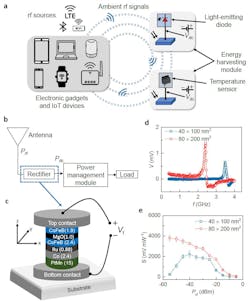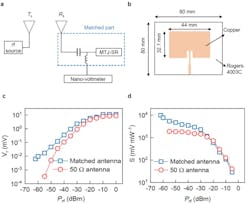Advanced Rectifier Overcomes Challenges of Harvesting Low-Level RF
What you’ll learn:
- Why harvesting low-level RF is difficult.
- How a new spin-rectifier implementation addresses a major limitation.
- The results achieved with the new component.
Energy harvesting has lots of positive aspects. After all, it offers the potential of getting something (energy) for nothing (or close to nothing). Among the harvestable sources, ambient RF energy is especially attractive due to its pervasive and ubiquitous nature.
Despite the apparent benefits, RF harvesting has a serious challenge: The very low level of the ambient RF generally means that the harvesting components are unable to function efficiently or effectively.
In such a an ambient-RF-signal power environment—typically less than −20 dBm (10 μW)—current rectifier technology either fails to operate or exhibits a low RF-to-DC conversion efficiency. While improving antenna efficiency and impedance matching can enhance performance, doing so also increases on-chip size, presenting obstacles to integration and miniaturization.
>>Check out the TechXchange for similar articles and videos.
A New “Spin” to RF Energy Harvesting
Addressing this conundrum, a team of scientists at the National University of Singapore (NUS), working in collaboration with researchers from Tohoku University (TU) in Japan and University of Messina (UNIME) in Italy, developed a novel compact and sensitive rectifier technology. It uses a nanoscale spin rectifier (SR) to convert ambient wireless radio-frequency signals at power less than −20 dBm to a DC voltage.
SRs based on magnetic tunnel junctions (MTJs) can overcome the low-power limitations of charge-based rectifiers and eliminate antenna and matching circuits. They can convert RF signal energy to a DC signal due to the spin-diode effect, where an applied RF current exerts a torque on the local spins of the free magnetic layer of the SRs (Fig. 1).
This results in a precession motion and resistance oscillation at the same frequency as the RF signal. The resistance oscillation with the RF current produces a rectified voltage (Vr) across the top and bottom contacts of the SR. As an added benefit, SRs are nano-sized, sensitive, CMOS compatible, and frequency-tunable.
State-of-the-art rectifiers such as Schottky diodes and tunnel diodes have reached efficiencies of 40% to 70% at RF powers (Prf) greater than −10 dBm. However, developing high-efficiency rectifiers for low-power regimes (Prf below −20 dBm) is difficult due to thermodynamic constraints and high-frequency parasitic effects.
The Mechanics Behind the Spin-Rectifier Configurations
The team optimized the SR devices and designed two configurations:
- A single SR-based rectenna operational between −62 dBm and −20 dBm
- An array of 10 SRs in series achieving 7.8% efficiency and zero-bias sensitivity of approximately 34,500 mV/mW
By integrating the SR-array into an energy-harvesting module, they successfully powered a commercial temperature sensor at −27 dBm.
Their nanoscale spin rectifiers can convert the RF signal to a DC voltage using the spin-diode effect. Although the SR-based technology surpassed the Schottky diode sensitivity, the low-power efficiency is still low (< 1%).
To overcome the low-power limitations, the research team studied the intrinsic properties of the SR, including the perpendicular anisotropy, device geometry, and dipolar field from the polarizer layer, as well as the dynamic response. The latter depends on the zero-field tunneling magnetoresistance and voltage-controlled magnetic anisotropy (VCMA). By combining these optimized parameters with the external antenna impedance-matched with a single SR, the researchers designed an ultra-low-power SR-rectenna.
To improve output and achieve on-chip operation, the SRs were coupled in an array arrangement, with the small co-planar waveguides on the SRs employed to couple RF power, resulting in compact on-chip area and high efficiency. Further, they designed SRs for optimal performance in the Wi-Fi (2.4 GHz), 4G (2.3-2.6 GHz), and 5G (3.5 GHz) bands.
Their basic SR achieved maximum sensitivity of ~3800 mV/mW and ~2200 mV/mW at Prf = −55 dBm and −40 dBm, which is higher than the zero-bias sensitivity of a state-of-the-art zero-bias Schottky diode. To improve sensitivity, they designed a high-gain, impedance-matched antenna to create an SR-rectenna (Fig. 2).
Fully understanding their spin-rectifier development obviously involves a deep dive into solid-state device physics. Fortunately, it’s all explained in detail in their lengthy yet highly readable paper, bolstered by a comprehensive supplementary information file. While the Nature Electronics paper “Nanoscale spin rectifiers for harvesting ambient radiofrequency energy” is behind a paywall, a complete open-access version is posted here as well.



